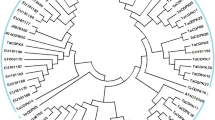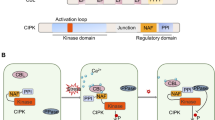Abstract
Main conclusion
Transgenic rice expressing pigeonpea Cc CDR conferred high-level tolerance to different abiotic stresses. The multiple stress tolerance observed in CcCDR -transgenic lines is attributed to the modulation of ABA-dependent and-independent signalling-pathway genes.
Stable transgenic plants expressing Cajanus cajan cold and drought regulatory protein encoding gene (CcCDR), under the control of CaMV35S and rd29A promoters, have been generated in indica rice. Different transgenic lines of CcCDR, when subjected to drought, salt, and cold stresses, exhibited higher seed germination, seedling survival rates, shoot length, root length, and enhanced plant biomass when compared with the untransformed control plants. Furthermore, transgenic plants disclosed higher leaf chlorophyll content, proline, reducing sugars, SOD, and catalase activities, besides lower levels of MDA. Localization studies revealed that the CcCDR-GFP fusion protein was mainly present in the nucleus of transformed cells of rice. The CcCDR transgenics were found hypersensitive to abscisic acid (ABA) and showed reduced seed germination rates as compared to that of control plants. When the transgenic plants were exposed to drought and salt stresses at vegetative and reproductive stages, they revealed larger panicles and higher number of filled grains compared to the untransformed control plants. Under similar stress conditions, the expression levels of P5CS, bZIP, DREB, OsLEA3, and CIPK genes, involved in ABA-dependent and-independent signal transduction pathways, were found higher in the transgenic plants than the control plants. The overall results amply demonstrate that the transgenic rice expressing CcCDR bestows high-level tolerance to drought, salt, and cold stress conditions. Accordingly, the CcCDR might be deployed as a promising candidate gene for improving the multiple stress tolerance of diverse crop plants.






Similar content being viewed by others
Abbreviations
- CcCDR:
-
Cold and drought regulatory protein
- CaMV 35S:
-
Cauliflower mosaic virus 35S promoter
- MDA:
-
Malonaldehyde
References
Bajaj S, Mohanty A (2005) Recent advances in rice biotechnology—towards genetically superior transgenic rice. Plant Biotechnol J 3:275–307
Bartels D, Singh M, Salamini F (1988) Onset of desiccation tolerance during development of the barley embryo. Planta 175:485–492
Bates LS, Waldren RP, Teare ID (1973) Rapid determination of free proline for water stress studies. Plant Soil 39:205–207
Boyer JS (1982) Plant productivity and environment. Science 218:443–448
Bray EA (1997) Plant responses to water deficit. Trends Plant Sci 2:48–54
Chen XP, Meng Y, Zhang M, Xia X, Wang P (2008) Over-expression of OsDREB genes lead to enhanced drought tolerance in rice. Biotechnol Lett 30:2191–2198
Dansana PK, Kothari KS, Vij S, Tyagi AK (2014) OsiSAP1 overexpression improves water-deficit stress tolerance in transgenic rice by affecting expression of endogenous stress-related genes. Plant Cell Rep 33:1425–1440
Davey MW, Stals E, Panis B, Keulemans J, Swennen RL (2005) High-throughput determination of malondialdehyde in plant tissues. Anal Biochem 347:201–207
Du YY, Wang PC, Chen J, Song CP (2008) Comprehensive functional analysis of the catalase gene family in Arabidopsis thaliana. J Int Plant Biol 50:1318–1326
Du HY, Shen YZ, Huang ZJ (2013) Function of the wheat TaSIP gene in enhancing drought and salt tolerance in transgenic Arabidopsis and rice. Plant Mol Biol 81:417–429
Duan J, Cai W (2012) OsLEA3-2, an abiotic stress induced gene of rice plays a key role in salt and drought tolerance. PLoS One 7:e45117
Dubouzet JG, Sakuma Y, Ito Y, Kasuga M, Dubouzet EG, Miura S, Seki M, Shinozaki K, Yamaguchi-Shinozaki K (2003) OsDREB genes in rice, Oryza sativa L., encode transcription activators that function in drought, high-salt- and cold-responsive gene expression. Plant J 33:751–763
Estrada- Melo AC, Chao Reid MS, Jiang CZ (2015) Overexpression of an ABA biosynthesis gene using a stress-inducible promoter enhances drought resistance in petunia. Hortic Res 2:15013. doi:10.1038/hortres.2015.13
Evenson RE, Gollin D (2003) Assessing the impact of the green revolution, 1960–2000. Science 300:758–762
Firon N, Nepi M, Pacini E (2012) Water status and associated processes mark critical stages in pollen development and functioning. Ann Bot 109:1201–1214
Godoy JA, Pardo JM, Pintor-Toro JA (1990) A tomato cDNA inducible by salt stress and abscisic acid: nucleotide sequence and expression pattern. Plant Mol Biol 15:695–705
He H, Serraj R (2012) Involvement of peduncle elongation, anther dehiscence and spikelet sterility in upland rice response to reproductive-stage drought stress. Environ Exp Bot 75:120–127
Hou X, Xie K, Yao J, Qi Z, Xiong L (2009) A homolog of human ski-interacting protein in rice positively regulates cell viability and stress tolerance. Proc Natl Acad Sci USA 106:6410–6415
Huang J, Sun SJ, Xu DQ, Yang X, Bao YM, Wang ZF, Tang HJ, Zhang H (2009) Increased tolerance of rice to cold, drought and oxidative stresses mediated by the overexpression of a gene that encodes the zinc finger protein ZFP245. Biochem Biophys Res Commun 389:556–561
Huang J, Sun S, Xu D, Lan H, Sun H, Wang Z, Bao Y, Wang J, Tang H, Zhang H (2012) A TFIIIA-type zinc finger protein confers multiple abiotic stress tolerances in transgenic rice (Oryza sativa L.). Plant Mol Biol 80:337–350
Ingram J, Bartels D (1996) The molecular basis of dehydration tolerance in plants. Annu Rev Plant Physiol Plant Mol Biol 47:377–403
Jakoby M, Weisshaar B, Droge-Laser W, Vicente-Carbajosa J, Tiedemann J, Kroj T, Parcy F (2002) bZIP transcription factors in Arabidopsis. Trends Plant Sci 7:106–111
Jiang SY, Bhalla R, Ramamoorthy R, Luan HF, Venkatesh PN, Cai M, Ramachandran S (2012) Over-expression of OSRIP18 increases drought and salt tolerance in transgenic rice plants. Transgenic Res 21:785–795
Kanneganti V, Gupta AK (2008) Overexpression of OsiSAP8, a member of stress associated protein (SAP) gene family of rice confers tolerance to salt, drought and cold stress in transgenic tobacco and rice. Plant Mol Biol 66:445–462
Li F, Han Y, Feng Y, Xing S, Zhao M, Chen Y, Wang W (2013) Expression of wheat expansin driven by the RD29 promoter in tobacco confers water-stress tolerance without impacting growth and development. J Biotechnol 163:281–291
Lu G, Gao C, Zheng X, Han B (2009) Identification of OsbZIP72 as a positive regulator of ABA response and drought tolerance in rice. Planta 229:605–615
Matsushima S (1966) Crop science in rice: theory of yield determination and its application. Fuji Publishing, Tokyo, p 365
McCouch SR, KochertG YuZH, Wang ZY, Kush GS, Coffman WR, Tanksley SD (1988) Molecular mapping of rice chromosomes. Theor Appl Genet 76:815–829
Mellacheruvu S, Tamirisa S, Vudem DR, Khareedu VR (2016) Pigeonpea hybrid-proline-rich protein (CcHyPRP) confers biotic and abiotic stress tolerance in transgenic rice. Front Plant Sci 6:1167. doi:10.3389/fpls.2015.01167
Miller GL (1959) Use of dinitrosalicylic acid reagent for determination of reducing sugar. Anal Chem 31(3):426–428
Murashige T, Skoog F (1962) A revised medium for rapid growth and bioassays with tobacco tissue cultures. Physiol Plant 15:473–497
Nguyen D, Rieu I, Mariani C, van Dam NM (2016) How plants handle multiple stresses: hormonal interactions underlying responses to abiotic stress and insect herbivory. Plant Mol Biol 91:727–740. doi:10.1007/s11103-016-0481-8
Oh S-J, Kim YS, Kwon C-W, Park HK, Jeong JS, Kim J-K (2009) Overexpression of the transcription factor AP37 in rice improves grain yield under drought conditions. Plant Physiol 150(3):1368–1379
Priyanka B, Sekhar K, Reddy VD, Rao KV (2010a) Expression of pigeonpea hybrid-proline-rich protein encoding gene (CcHyPRP) in yeast and Arabidopsis affords multiple abiotic stress tolerance. Plant Biotechnol J 8:76–87
Priyanka B, Sekhar K, Sunita T, Reddy VD, Rao KV (2010b) Characterization of expressed sequence tags (ESTs) of pigeonpea (Cajanus cajan L.) and functional validation of selected genes for abiotic stress tolerance in Arabidopsis thaliana. Mol Genet Genomics 283:273–287
Ramesh S, Nagadhara D, Reddy VD, Rao KV (2004) Production of transgenic indica rice resistant to yellow stem borer and sap-sucking insects, using super-binary vectors of Agrobacterium tumefaciens. Plant Sci 166:1077–1085
Sah SK, Reddy KR, Li J (2016) Abscisic acid and abiotic stress tolerance in crop plants. Front Plant Sci 7:571. doi:10.3389/fpls.2016.00571
Sambrook J, Russell DW (2001) Molecular cloning: a laboratory manual, 3rd edn. Cold Spring Harbor Laboratory Press, New York
Srinath T, Reddy VD, Rao KV (2014) Ectopic expression of pigeonpea cold and drought regulatory protein (CcCDR) in yeast and tobacco affords multiple abiotic stress tolerance. Plant Cell Tissue Organ Cult 119:489–499
Tamirisa S, Vudem DR, Khareedu VR (2014) Overexpression of pigeonpea stress-induced cold and drought regulatory gene (CcCDR) confers drought, salt, and cold tolerance in Arabidopsis. J Exp Bot 65:4769–4781
Tang N, Zhang H, Li X, Xiao J, Xiong L (2012) Constitutive activation of transcription factor OsbZIP46 improves drought tolerance in rice. Plant Physiol 158:1755–1768
Thompson AJ, Jackson AC, Symonds RC, Mulholland BJ, Dadswell AR, Blake PS, Burbidge A, Taylor IB (2000) Ectopic expression of a tomato 9-cis-epoxycarotenoid dioxygenase gene causes over-production of abscisic acid. Plant J 23(3):363–374
Tyagi AK, Mohanty A (2000) Rice transformation for crop improvement and functional genomics. Plant Sci 158:1–18
Wang Q, Guan Y, Wu Y, Chen H, Chen F, Chu C (2008) Overexpression of a rice OsDREB1F gene increases salt, drought, and low temperature tolerance in both Arabidopsis and rice. Plant Mol Biol 67:589–602
Xiang Y, Huang Y, Xiong L (2007) Characterization of stress-responsive CIPK genes in rice for stress tolerance improvement. Plant Physiol 144:1416–1428
Xiang Y, Tang N, Du H, Ye H, Xiong L (2008) Characterization of OsbZIP23 as a key player of the basic leucine zipper transcription factor family for conferring abscisic acid sensitivity and salinity and drought tolerance in rice. Plant Physiol 148:1938–1952
Xiao B, Huang Y, Tang N, Xiong L (2007) Over-expression of a LEA gene in rice improves drought resistance under the field conditions. Theor Appl Genet 115:35–46
Yang S, Vanderbeld B, Wan J, Huang Y (2010) Narrowing down the targets: towards successful genetic engineering of drought-tolerant crops. Mol Plant 3:469–490
Yarasi B, Sadumpati V, Immanni CP, Reddy VD, Rao KV (2008) Transgenic rice expressing Allium sativum leaf agglutinin (ASAL) exhibits high-level resistance against major sap-sucking pests. BMC Plant Biol 8:102
Zhou W, Li Y, Zhao BC, Ge RC, Shen YZ, Wang G, Huang ZJ (2009) Overexpression of TaSTRG gene improves salt and drought tolerance in rice. J Plant Physiol 166:1660–1671
Zou M, Guan Y, Ren H, Zhang F, Chen F (2008) A bZIP transcription factor, OsABI5, is involved in rice fertility and stress tolerance. Plant Mol Biol 66:675–683
Acknowledgements
This project is supported by grants from the Osmania University, Hyderabad, India. MS and TS are thankful to the University Grants Commission, New Delhi, for the award of a Research Fellowship. The authors are grateful to Prof. T. Papi Reddy of the Department of Genetics, Osmania University, for his suggestions.
Author information
Authors and Affiliations
Corresponding author
Ethics declarations
Conflict of interest
Authors do not have any conflict of interest.
Additional information
M. Sunitha and T. Srinath contributed equally.
Electronic supplementary material
Below is the link to the electronic supplementary material.
Rights and permissions
About this article
Cite this article
Sunitha, M., Srinath, T., Reddy, V.D. et al. Expression of cold and drought regulatory protein (CcCDR) of pigeonpea imparts enhanced tolerance to major abiotic stresses in transgenic rice plants. Planta 245, 1137–1148 (2017). https://doi.org/10.1007/s00425-017-2672-1
Received:
Accepted:
Published:
Issue Date:
DOI: https://doi.org/10.1007/s00425-017-2672-1




